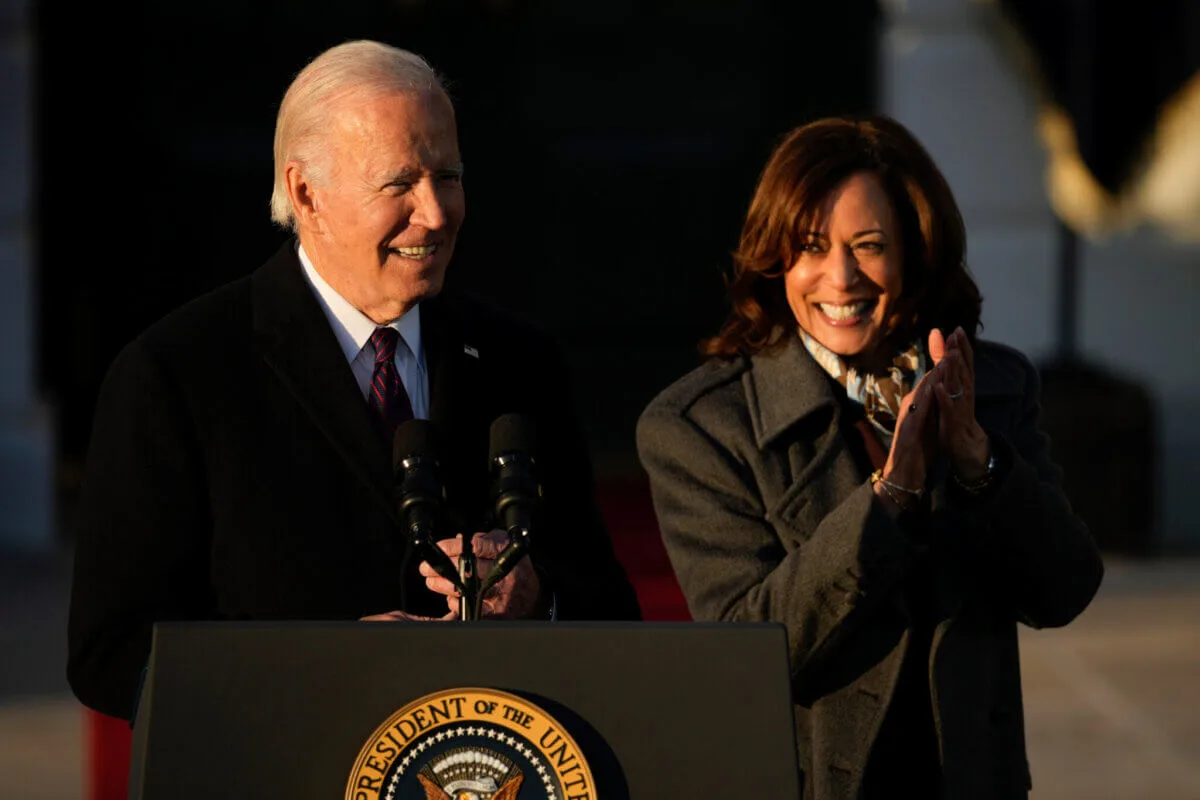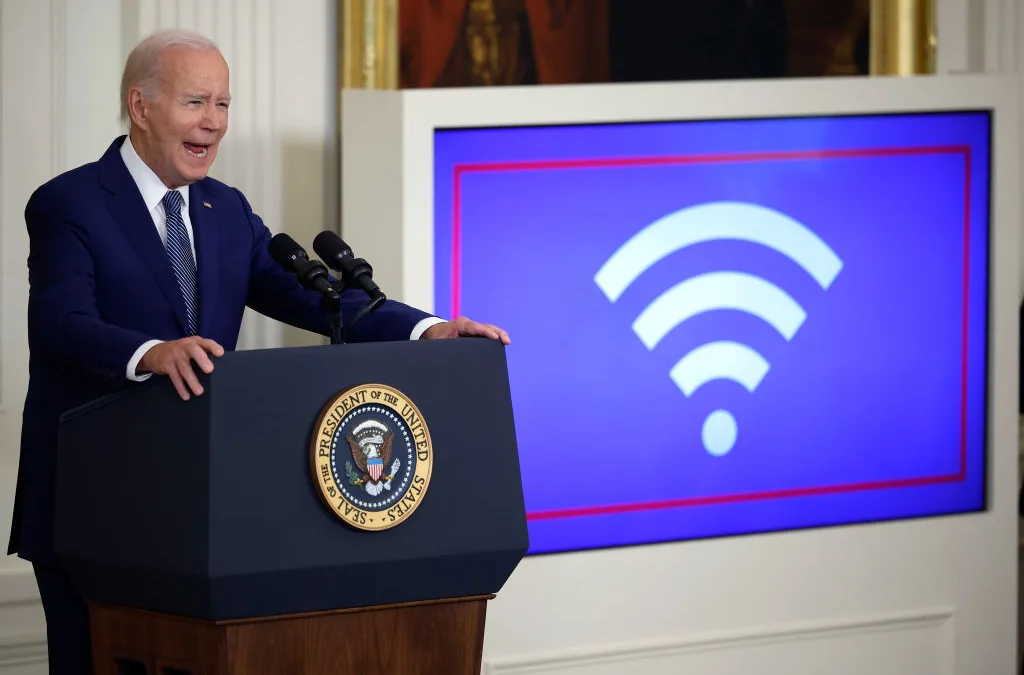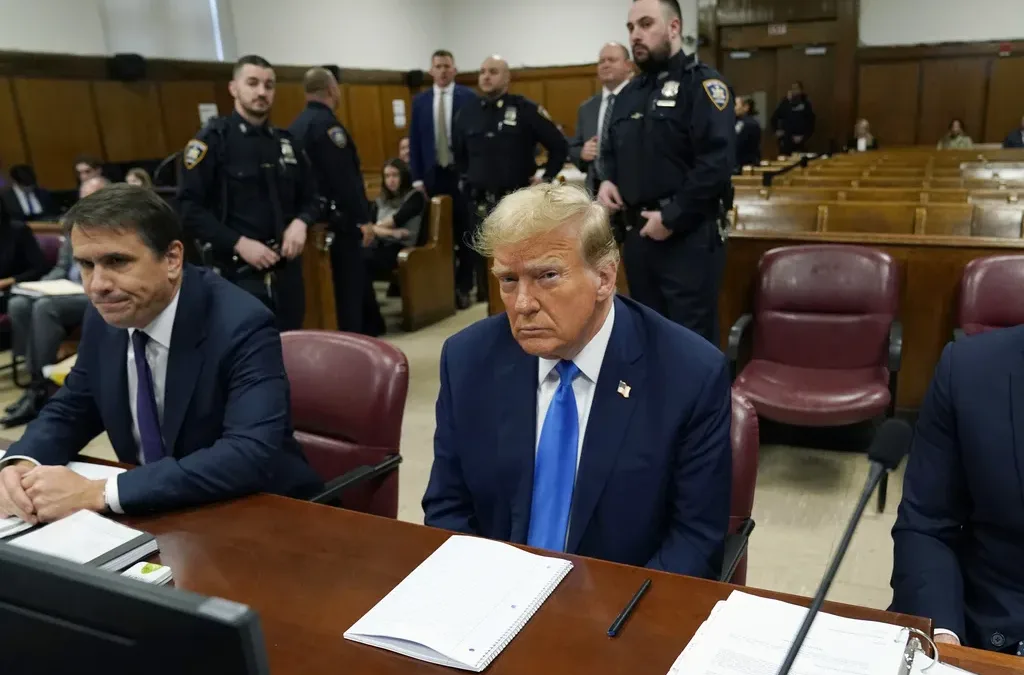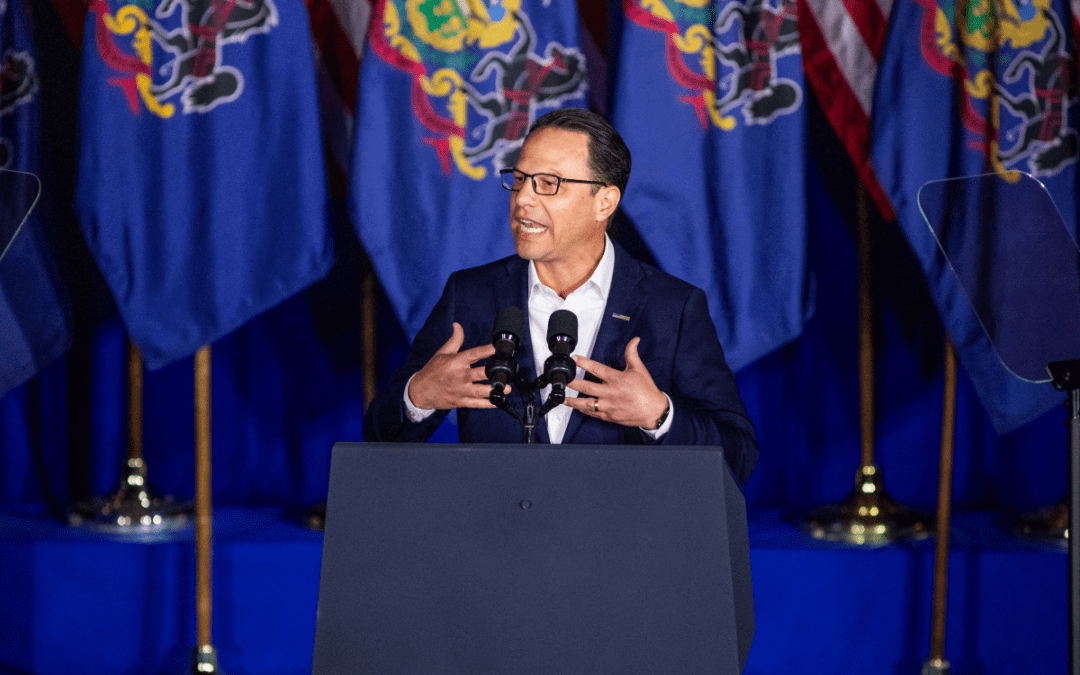
Vice President Kamala Harris applauds as President Joe Biden speaks during a bill signing ceremony for the Respect for Marriage Act, Tuesday, Dec. 13, 2022, on the South Lawn of the White House in Washington. (AP Photo/Andrew Harnik)
Over the past two years, the Biden-Harris administration and the Democratic-run House and Senate acted to lower healthcare and drug costs; fight climate change and reduce energy costs; invest in mental health care; and invest in American manufacturing and infrastructure.
Friday marks the second anniversary of the Biden-Harris administration, and it’s been an eventful 24 months, to say the least. President Joe Biden has overseen the nation’s economic recovery from the worst of the coronavirus pandemic, with more than 10 million jobs created over the past two years and unemployment reaching a 50-year low in December.
Biden has also signed dozens of impactful bills into law and has already arguably had the most accomplished presidency of any Democrat since Lyndon Johnson in the 1960s.
Here are 10 ways the Biden administration has delivered for American workers and families over the past two years:
1. Lowering Healthcare and Drug Costs
In August, President Joe Biden signed the Inflation Reduction Act into law. By doing so, he extended generous subsidies that make Affordable Care Act (ACA) health insurance plans more affordable. Those subsidies—introduced as part of Biden’s American Rescue Plan in 2021—were set to expire at the end of 2022, but the Inflation Reduction Act extends them through 2025.
The law will prevent an estimated 3 million Americans from losing their ACA insurance and 10.4 million more enrollees from paying more for their insurance plans.
The Inflation Reduction Act also reforms Medicare to lower drug costs for tens of millions of seniors with Medicare Part D coverage, which covers prescription drugs.
As of this month, no Medicare recipient will spend more than $35 a month on insulin. More than 3.3 million Medicare beneficiaries nationwide rely on insulin, with the average patient spending $54 a month on prescriptions—an increase of nearly 40% in the past 15 years—according to the Kaiser Family Foundation. Some Medicare recipients spend over $100 a month on insulin, though, as certain brands charge higher prices than others.
If you’re a Medicare recipient, here’s how else the bill benefits you:
- As of this month, all vaccines covered under Medicare Part D are completely free.
- The bill will cap out-of-pocket spending on prescription drugs to $2,000 a year starting in 2025 for seniors with Medicare Part D prescription drug plans.
- It requires Medicare to negotiate the cost of 10 high-cost prescription drugs beginning in 2026, with additional drugs added in future years.
2. Fighting Climate Change and Saving Families Money on Energy
Biden’s signature legislative accomplishment, the Inflation Reduction Act, also represents the largest-ever national investment in fighting climate change. The law is predicted to create up to 9 million jobs over the next decade while reducing premature deaths from air pollution and helping the US dramatically reduce climate change-causing emissions.
The Inflation Reduction Act will accelerate private companies’ transition to clean energy technologies, expand domestic manufacturing of clean energy products, and boost American energy independence to make the country less reliant on foreign oil—all while making renewable energy products a financial winner for families.
Here’s how: The Inflation Reduction Act extends and adopts hundreds of billions of dollars in new tax credits to incentivize industries and utilities to move toward solar, wind, hydropower, and nuclear power. Manufacturers could get subsidies for building electric vehicles (EVs) and renewable energy products, while utilities could get credits for choosing solar and wind energy over fossil fuel plants.
Importantly, the law also provides $80 billion in financial rebates for millions of households to adopt those clean energy products, such as electric vehicles, solar panels, and more efficient heat pumps.
If consumers claim all the subsidies offered in the law, they could save more than $1,800 on their annual energy bill on average, according to an analysis by Rewiring America, a climate analysis group. The organization also has a handy calculator to help you figure out which rebates and credits you’re eligible for.
If you’re asking where the funding for these subsidies and the healthcare measures comes from, the answer is by imposing a minimum tax on large, tax-dodging corporations.
Notably, the Inflation Reduction Act does NOT raise taxes on small businesses or Americans earning under $400,000 a year.
3. The Most Consequential Federal Gun Safety Bill in Decades
In the aftermath of last May’s devastating mass shooting at an elementary school in Uvalde, Texas, Congress finally passed legislation that aims to address the scourge of gun violence.
While the Bipartisan Safer Communities Act doesn’t go as far as most gun safety activists would like, it enhances background checks for prospective gun buyers under the age of 21 and requires law enforcement authorities to have time to examine juvenile records, including mental health records beginning at age 16.
The law also funds community-based violence interruption programs and provides up to $750 million in funding to incentivize states to pass “red flag” laws that allow officials to temporarily take away guns from people deemed in court to be a threat to themselves or others.
The Bipartisan Safer Communities Act also makes it more difficult for domestic abusers to buy guns by adding anyone convicted of domestic violence to the National Instant Criminal Background Check System.
4. The Largest-Ever National Investment in Mental Health
The Bipartisan Safer Communities Act was largely discussed as a gun safety bill, but in reality, the bill is actually more of an investment in mental health than anything else.
The law provides roughly $10 billion in funding for mental healthcare, the largest-ever investment in America’s mental healthcare system and a critical one at a time when rates of anxiety and depression are on the rise, especially among young Americans.
Most of that funding will go towards expanding certified community behavioral health clinics in every state. These clinics, which already exist in a handful of states as part of a Medicaid pilot program, are required to treat patients for mental health and/or substance use issues, regardless of their insurance coverage. These clinics also provide 24/7 crisis response, medication-assisted treatment, and have shown promise in treating patients.
The bill also includes $1 billion to increase the number of mental health counselors in schools, provide additional funding for pediatric mental health care, distribute grants for mental and behavioral health organizations and community groups, and establish additional funding for the new 988 National Suicide Prevention Lifeline.
5. Canceling Up to $20,000 in Federal Student Loans for Tens of Millions of Americans
More than 43 million Americans hold $1.6 trillion in federal student loan debt, a crisis brought on by the skyrocketing cost of higher education and stagnant levels of federal aid, which together have forced millions of students from middle- and low-income families to take on burdensome loans.
In August, President Joe Biden delivered these Americans welcome news when he announced an executive order to cancel up to $20,000 in federal student loan debt for tens of millions of borrowers and make systemic changes to ensure future repayment terms are far more fair for low- and middle-income borrowers.
Under Biden’s plan, an estimated 20 million people are expected to be eligible to have their remaining debt fully canceled, with benefits overwhelmingly flowing to Americans earning under $75,000 per year.
Biden’s plan has faced numerous Republican lawsuits, as right-wing politicians and activists have made it their mission to deny millions of working-class Americans economic relief.
One of those lawsuits has proven effective. In November, a US Circuit Court of Appeals blocked Biden’s plan from being implemented as part of a lawsuit filed by six states with Republican attorneys general. The US Supreme Court upheld the injunction blocking Biden’s plan, ensuring it remains blocked until they rule on the case. The Court plans to hear arguments in the case in February and issue a decision by June.
About 26 million people have already applied for debt cancellation, and 16 million borrowers have been informed that they’ve been approved for relief, but because of the lawsuits, no debt has been canceled yet.
Anticipating the Supreme Court would take up the case, the Biden administration announced in November that they would extend the pause on federal student loan payments until after the case was resolved, with payments resuming 60 days after that. If the administration is unable to implement its cancellation plan and legal challenges are unresolved by June 30, payments will resume 60 days later, on Sept. 1.
6. A Generational Investment in American Industry and Manufacturing
You might have noticed that products like cars, cell phones, refrigerators, and gaming consoles were harder to come by during the pandemic, as supply chain issues affected the availability of these products in the US and sent prices surging, particularly for vehicles.
These shortages occurred because these items—as well as many other products—rely on microchips that are overwhelmingly manufactured in Taiwan.
The CHIPS and Science Act, which Biden signed into law in August, aims to change that by dramatically increasing domestic microchip manufacturing, a move that aims to strengthen supply chains, lower costs for consumers, create jobs for American workers, and make the US more economically independent.
The law allocates $39 billion in incentives for companies to construct and expand manufacturing facilities in the US and $13.2 billion for workforce development programs and research and development efforts.
The law already appears to be paying dividends, as several companies have announced new investments or increased previous ones to boost domestic microchip manufacturing in the US and create tens of thousands of jobs.
The law also invests approximately $170 billion in the Department of Energy, National Science Foundation, and other federal agencies that are focused on technology, innovation, and manufacturing in an effort to make America more competitive with China and other countries.
7. Billions of Dollars in Investments in Workers, Families, and Communities
Last year was a huge one for the Biden administration’s legislative accomplishments, but so was 2021, when the federal government passed the American Rescue Plan (ARP) and the Infrastructure Investment and Jobs Act. The American Rescue Plan was best known for providing $1,400 stimulus checks to most Americans and expanding the child tax credit for parents, but those temporary policies obscured some of the long-term investments provided by the law.
In 2022, many of those investments began to come to fruition. Just last month, for example, the Biden administration announced $36 billion in funding to protect workers’ pensions. The funds—which come from the ARP’s Special Financial Assistance Program—will prevent substantial cuts to the pensions of more than 350,000 union workers and retirees.
The American Rescue Plan also:
- Provided $40 billion in funds to invest in and create opportunities for America’s workers
- Provided funding for public safety and crime reduction efforts
- Funded affordable housing development across the country
- Provided much-needed financial support to small businesses
- Invested in healthcare centers and mental health treatment
- Expanded food assistance programs to keep American families out of hunger
- Expanded child care assistance and invested in schools and childcare programs
The Infrastructure Investment and Jobs Act, meanwhile, represented the largest single investment in America’s infrastructure in more than a half-century. The law allows for the investment of hundreds of billions of dollars to upgrade, modernize, and improve America’s infrastructure.
Many of those projects came to life in 2022, with more than $185 billion in funding approved for nearly 7,000 specific projects across all 50 states, according to the White House. An interactive map of projects underway can be seen here. These efforts include:
- 2,800 bridge repair and replacement projects
- More than $3 billion in funds to upgrade infrastructure at more than 3,000 airports
- More than $9 billion to improve America’s water infrastructure, pipes and services lines, and sewer systems.
- More than $3 billion in funding to make homes more energy-efficient and more than $200 million to help families pay outstanding energy bills.
- More than $2.3 billion to help states, tribal nations, and territories upgrade and modernize America’s power grid.
- Financial assistance to nearly 15 millions of households to help them afford high-speed internet
8. Reducing the Cost of Gas by Releasing Oil from the National Strategic Reserve
Few issues got more headlines last year than inflation—specifically the high cost of gas, a spike caused by a combination of factors, including lingering supply chain issues from the coronavirus pandemic, Russia’s war on Ukraine, and corporate greed.
While the president has little control over gas prices, Biden repeatedly called out the profiteering of oil and energy companies this year and demanded they use some of their record profits to lower costs for consumers, rather than on stock buybacks.
Biden also utilized what flexibility he did have to release hundreds of millions of barrels of oil from the nation’s Strategic Petroleum Reserve, which lowered the cost of gasoline by somewhere between 13 and 31 cents per gallon, according to an analysis from the US Treasury Department.
Gas prices reached their peak in the early summer but have been on a steady decline ever since, with the national average price of a gallon of gas down to $3.38 per gallon as of Jan. 19, according to AAA.
There are several factors driving the decline, including the Biden administration’s release of petroleum from the strategic reserve, an increase in domestic refining capacity, and decreased global demand for gasoline, particularly in China.
9. Improving Healthcare for Veterans Affected by Burn Pits
For years, tens of thousands of US veterans who were exposed to cancer-causing toxins from burn pits while serving overseas—mostly in Afghanistan and Iraq—struggled to access the care they needed.
But last summer, Congress passed and President Biden signed the Promise to Address Comprehensive Toxics (PACT) Act into law, expanding health care coverage for more than 3.5 million veterans exposed to toxins while serving.
The law removes a bureaucratic barrier for veterans seeking care and establishes a presumption that factors during a veteran’s service are connected to 23 different respiratory illnesses and cancers related to the smoke from burn pits—which were heavily used in war zones to dispose of household and human waste and toxic substances like paint and metals.
10. Reforming the US Postal Service to Ensure Long-Term Stability
More than half a million Americans work for the US Postal Service, and hundreds of millions rely on the mail agency to deliver everything from medication to paychecks to food. But the agency’s finances have long been in crisis, due to a decline in mail volume and a 2006 law that required the USPS to pre-fund retirees’ healthcare costs.
In early 2022, the federal government acted to address these issues as Congress passed and Biden signed the Postal Service Reform Act, a $107 billion bipartisan law that will modernize the organization and ensure financial stability.
The Postal Service Reform Act also requires the USPS to maintain its standard of delivering mail at least six days per week and create a public, online dashboard with national and local level service performance data updated each week to provide transparency and promote compliance with on-time delivery of mail.
Finally, the law allows the USPS to partner with state, local, and tribal governments to offer non-mail services such as hunting and fishing licenses in order to provide more value to the public.
The government’s decision to approve the law and ensure the financial stability of the agency means that Americans who most rely on the USPS—such as retirees and rural residents—will continue to receive their mail in a timely, consistent fashion.
A Few More Accomplishments That Really Matter
It was difficult to narrow the list down to just 10 accomplishments, so here are just a few more:
- Biden led the global alliance that has supported Ukraine and provided billions in funding to help the democratic country defend itself against Russia’s brutal invasion.
- In December, the president signed the Respect for Marriage Act into law, a key step in protecting marriages between same-sex and interracial couples at the federal level. The law requires states that ban same-sex marriages to recognize these marriages as long as the marriage was valid in the state where it was performed. This would offer some protections to same-sex couples in the event that the Obergefell ruling is ever overturned and state-level bans are allowed to go into place.
- Biden oversaw the reauthorization of the Violence Against Women Act, which aims to protect victims of domestic violence, sexual assault, and stalking. The landmark law needs to be renewed every five years and had previously lapsed in 2019.
- Biden nominated and Senate Democrats confirmed the first Black woman to serve on the US Supreme Court, Justice Ketanji Brown Jackson.
- In October, Biden pardoned all prior federal offenses of simple marijuana possession, which will help thousands of people who were previously convicted of simple possession who may be denied employment, housing, or educational opportunities as a result. In December, he signed the the Medical Marijuana and Cannabidiol Research Expansion Act, which provides federal support to facilitate research of marijuana for possible medical use.
Politics

736,000 PA households could lose crucial help on their internet bills
Time is running out for the Affordable Connectivity Program, which provides low-cost high speed internet access for over 736,000 Pennsylvania...

What to know about Trump’s legal issues
Over the past year, former president Donald Trump has become the center of not one, not two, not three, but four criminal investigations, at both...

Shapiro aims to eliminate waiting list for services for intellectually disabled adults
HARRISBURG, Pa. (AP) — Gov. Josh Shapiro and his top human services official said Wednesday that the administration has a plan to end a waiting list...
Local News

Conjoined twins from Berks County die at age 62
Conjoined twins Lori and George Schappell, who pursued separate careers, interests and relationships during lives that defied medical expectations,...

Railroad agrees to $600 million settlement for fiery Ohio derailment, residents fear it’s not enough
Norfolk Southern has agreed to pay $600 million in a class-action lawsuit settlement for a fiery train derailment in February 2023 in eastern Ohio,...






